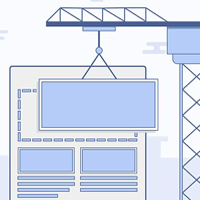Top 10 Web Development Trends of 2017

Technology is constantly changing. As a Web developer, you need to stay ahead of the game by changing with technology. The confusing thing is that there are many developments and updates being released on a weekly basis.
With the year in full swing, let's review the top 10 Web development trends that could impact website design updates and complete overhauls. This will help you better anticipate trends as well as understand where to devote resources (time and money) within the world of Web development.
1. Artificial Intelligence for Web and App Creation
Artificial intelligence (AI) software is already in use by major corporations such as Wikipedia, Google and Netflix. Technology that allows us to create programs that can act and think like humans is within our reach now. Without a doubt, we should expect more developers to adopt these programs and improve their abilities. This technology is already allowing amateurs to produce great websites using AI programs such as Molly. You only need to come up with the content and this program will do the rest.

(Image source)
2. JavaScript Evolution
There is a lot of debate going on in relation to Web development and the ideal language to use. The truth is that there is no right or wrong program, it's all dependent on your focus. Learning JavaScript in 2017 will be quite difficult, but there are always great resources online. We have seen the rise of TypeScript, which is a statistically typed language with the ability to compile to JavaScript. This means you have the ability to use existing JS code, incorporate your libraries and call the TypeScript code from JS and this is pretty amazing.
3. Internet of Things
 The Internet is now not only restricted to mobile phones and computers, it is also moving into household appliances like your thermostat, refrigerator and even everyday items like your dish soap (thanks to Amazon Dash). People now have the luxury of finding their coffee ready the moment they get to the kitchen or scheduling their brewing system from their phone. Developers will need to research how to code for new IoT offerings. With Amazon Web Service IoT button, for instance, developers can "code the button's logic in the cloud to configure button clicks to count or track items, call or alert someone, start or stop something, order services, or even provide feedback."
The Internet is now not only restricted to mobile phones and computers, it is also moving into household appliances like your thermostat, refrigerator and even everyday items like your dish soap (thanks to Amazon Dash). People now have the luxury of finding their coffee ready the moment they get to the kitchen or scheduling their brewing system from their phone. Developers will need to research how to code for new IoT offerings. With Amazon Web Service IoT button, for instance, developers can "code the button's logic in the cloud to configure button clicks to count or track items, call or alert someone, start or stop something, order services, or even provide feedback."
As more developers code these type of IoT buttons to help consumers do anything from start their car to call their spouse, consumer demands for automation will need to be met.
Technology is on the fast lane to help us control our lives from smartphones, so Web developers will need to get ahead of this trend and adjust their approach accordingly.
4. Static Site Generators
Static site generators are solidifying their position in Web development. These generators are great in creating websites. You will not need a database because the Web pages are simple files running on your server. This comes with a boatload of benefits such as improved security, easy deployment and faster website loading times. APIs and content delivery networks are becoming everyday options and this has resulted in static generators such as Jekyll and Hugo (shown below) to ride the wave of popularity.

5. Conversation UI roles and Bots
Bots are created to improve the experience of uses and make thing easier for them. There was a prediction that conversational commerce will take over. Messaging platforms are becoming more popular every day and their influence on Web development and design cannot be ignored. Websites are jumping on the conversational UI trend and developers need to pay close attention to this. The best example is the chat bots used in various website customer support sections and within Facebook Messenger.
6. Ruby On Rails
The release of Ruby on Rail 5 has catapulted this trend to popularity and it is expected that this will be popular throughout the year. Rails have been under the radar and seem to have not been in a position to make a solid impact. Ruby on Rail 5 will give developers a chance to focus on the appearance of the website and this framework makes sure that all the behind the scene messes are sorted.
7. Motion UI
Last year, there was a prediction that motion UI was going to be among the top 10 Web development trends in 2017. Well, this prediction was not wrong because Motion UI has already gained massive popularity and it is not showing any signs of stopping any time soon. Motion UI's newest version works through flexible CSS patterns with different JavaScript libraries. It also enables animation integration seamlessly into a website. This means Web pages are no longer two dimensional or boring.
8. Angular JS Next Generation
Angular update was released in 2016 and introduced a next generation JavaScript Framework. The update is now expected to be more regular with significant updates being promised at least once every six months. Angular is best suited for app developers because of animation, video and non-static documents compatibility.
9. Experience over Appearance
Modern developers are now building websites with a focus on the user experience. This is because even search engines are rewarding websites that are giving users a good experience (being shown in fewer bounces, more device friendly, etc.). Instead of using the basic frameworks that result in plain websites, developers will incorporate extra elements that will improve interactivity and engagement. This will include making links look more identifiable on mobile phones and computers. You likely have noticed parallax designs where the foreground is scrolling at a different speed than the background. This is interesting and improves the user experience.
10. Long Scrolling
A while ago, long scrolling websites were discouraged. Today, they are in the list of the top 10 web development trends in 2017 for a reason. In the past, long scrolling has been perceived as useless but it is now integral parts of development. Mobile phones have changed the development industry because these devices come with new rules that change how things are done. Long scrolling has specifically been popularized by mobile phones since it is easier to scroll longer than click on links and wait for the next page to load.
About the Author Derek Robinson is the founder and CEO of Top Notch Dezigns, a Web design and digital marketing company located in New York. In his free time loves to share his knowledge about the Web design industry.
Keep Reading:









